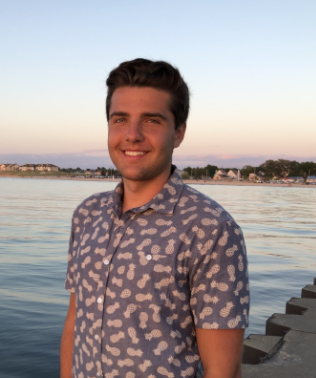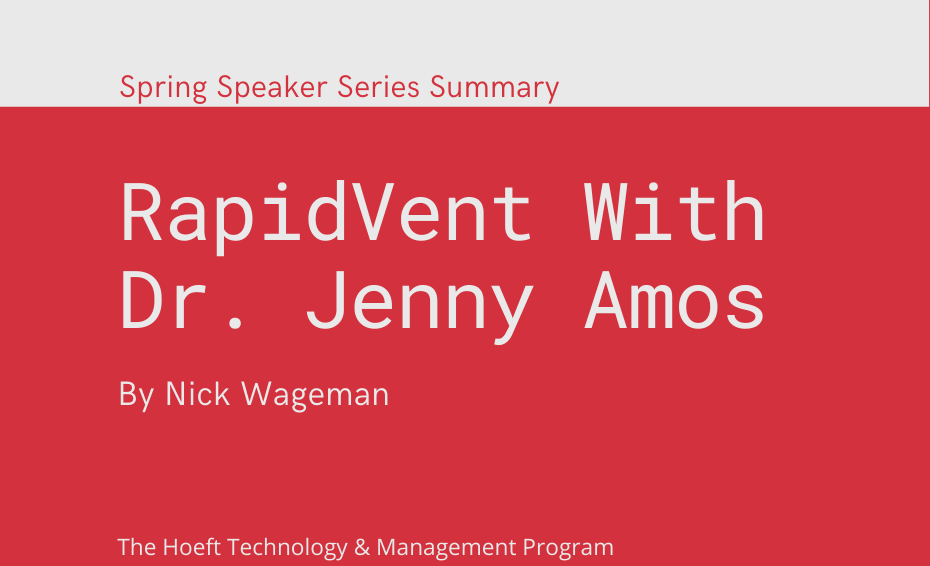By Nick Wageman
It is no secret that the global pandemic this past year has been a damper on many people’s minds and souls. While we are finally seeing things begin to go back to a version of normalcy, it is important to remember the devastation that this pandemic caused and how we can improve upon our response should another disaster like this ever happen again. One of the most experimental and successful groups which dealt with the rapid response of the Covid-19 virus was the RapidVent team composed of professionals at UIUC, Carle Hospital, and other organizations and commissioned by Dean Rashid Bashir himself. The RapidVent team successfully designed, prototyped, and tested a functioning ventilator for emergency use in overburdened hospitals in only 12 days; a feat that almost sounds impossible.
Dr. Jenny Amos personally contributed her entire spring break plus some to the RapidVent technology and is now spreading her experience as a member of a very successful rapid response team. Dr. Amos has a B.S. in Chemical Engineering and a minor in Computer Science from Texas Tech University in 2004 as well as a Ph.D. in Chemical Engineering with a concentration in Cell and Developmental Biology from the University of Southern California in 2008. Dr. Amos has been working and teaching at the University of Illinois for the past 12 years helping students with their senior design projects and master’s capstone projects in the bioengineering department. She is also involved in many other organizations and professional societies and is definitely worth a search. The RapidVent project was split into nine sub-teams of which Dr. Amos was a core member of the Engineering and Test team, the User Experience team, and the Sensors and Alarms team while also contributing to virtually every other aspect of the project as well. I am extremely excited to share the information that Dr. Amos generously shared with the T&M program last Friday about her feelings towards RapidVent and what she thinks made this rapid response team so incredibly effective.
As stated earlier, this team was formed in only days during a time when nobody really knew anything at all about how severe the Covid virus could become. Mark Johnson, an MD from Carle Hospital, quickly reached out to the University of Illinois with worries that they were harshly underprepared should Covid ever break out in the area. With only 700 testing kits and 500 beds available and enough ventilators to last about two weeks, it was imperative that action was taken immediately or lives would be lost. With advice from both Dr. Johnson as well as other doctors throughout the country, Dean Bashir finally came to the conclusion that he had to put together a team that would drop everything they have been working on to solely focus on creating an emergency ventilator. Thus, Dr. Amos was recruited and the grueling 12-day process of designing and prototyping a ventilator system from scratch began.
Dr. Amos’s two main tips for building rapid response teams are selecting many people from very diverse backgrounds and always keeping the end goal in sight. The RapidVent team consisted of nine sub-teams including supply chain, engineering and testing, leadership and management, human and animal subjects, government relations, communication, user experience, and sensors and alarms. Because of Dr. Amos’s unique expertise and background, she was specifically chosen to contribute to three out of these nine teams. Similarly, other members of RapidVent were specifically chosen for their roles because of their unique backgrounds and fields of study and work. Many team members were not even engineers, which is to be expected since some of the sub-teams dealt more with the legalities and marketing rather than the actual design and engineering of the product. It simply wouldn’t be efficient or effective to have a full team of mechanical engineers even if the goal of the team is to design something mechanical. Another way the RapidVent team was able to acquire diversity was by communicating with doctors and consultants all around the country. One of the first people Dean Bashir went to after consulting with Doctor Johnson at Carle, was Nick Mark, an MD at Seattle Hospital. Gaining insight from Dr. Mark and other professionals around the country set RapidVent apart as being more inclusive to everybody’s needs as opposed to only a small bubble of people’s needs at this University. Dr. Amos taught us that you don’t have to be a jack of all trades to be an effective team member, but rather do a quality job on your own expertise and let other people focus on their expertise.
The other piece of advice that Dr. Amos gave is to always keep your goals in sight. This was especially apparent for RapidVent since the 12-day process began right as spring break was beginning. While most of the country was still largely unaware of the threat that Covid posed and was enjoying their time off, Dr. Amos and the team were relentlessly working from dawn till dusk each and every day. Dr. Amos had a 7 am check-in meeting along with several other sub-team meetings every day even on the weekends. On one of the days, she had the entire user manual due on top of all her other work for the project. When asked how she was able to stay motivated during this process, Dr. Amos said that she just had to keep the end goal in mind which was that this work is going to save lives. Without this goal, it would have been so easy for Dr. Amos to get distracted and miss deadlines just because she needed a break or she may have even just quit the project because it was too much work. The point is that Dr. Amos and the rest of the team selflessly gave up every second of their lives for these 12 days because they held on to what the project was all about even as they had zoom meeting after zoom meeting after zoom meeting. This advice also extends to really any work even outside of rapid response teams. By staying calm and focused on the end goal, it will take much longer to feel burnt out and exhausted in the work that you are doing. This also shows why it is so important to choose a career that you genuinely enjoy or else it will be exponentially more difficult to succeed within that career.
In conclusion, the rapid response of the RapidVent team is a remarkable story of dedication and ingenuity that will surely be talked about for many years to come. The lessons learned and the experiences of every team member deserved to be shared and utilized in the future to ensure that we will always be prepared even if the unimaginable happens. As students and young professionals we are always learning from the past and our own mistakes, now let’s take a second to learn from this success story and apply it to our own development and careers.

Nick Wageman
Nick is a sophomore in T&M Class XXVII. He is studying Engineering Mechanics and is an incoming Production Engineering Intern at G&W Electric Company.
